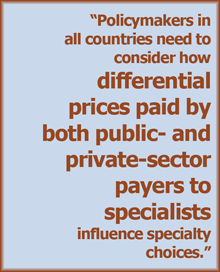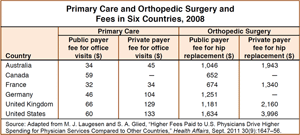Synopsis
A study comparing prices for physician services in the United States with those in five other nations found that both public and private payers in the U.S. paid somewhat higher fees to primary care physicians for office visits, and much higher fees to orthopedic surgeons for hip replacements, compared with payers abroad.
The Issue
Physician spending per capita in the United States is much higher than in other countries. While most analysts agree that higher prices are a primary reason for the higher spending, some have suggested that prices for certain services, such as primary care, are not high enough. This Commonwealth Fund–supported study, published in Health Affairs, compared the costs of primary care office visits and hip replacement surgery in Australia, Canada, France, Germany, the United Kingdom, and the United States. The authors also compared prices paid by public and private insurers in each of the comparison countries.
Key Findings
- Public payer fees for an office visit ranged from $34 in Australia to $66 in the United Kingdom; private payer fees ranged from $34 in France to $133 in the United States.
- U.S. primary care physicians were paid an average of 27 percent more by public payers for an office visit, and 70 percent more by private payers for an office visit, compared with the average amount paid in other countries.
- Public program fees for hip replacements ranged from $652 in Canada to $1,634 in the U.S. In the U.S., private health insurance fees for hip replacements were nearly $4,000—twice as high as the private rates in the five other countries.
- U.S. payers paid much higher fees to orthopedic physicians for hip replacements: public payers paid 70 percent more, while private payers paid 120 percent more.
- U.S. primary care physicians earned an average $186,582, compared with a range of $92,844 (Australia) to $159,532 (U.K). U.S. orthopedic surgeons earned an average $442,450, compared with a range of $154,380 (France) to $324,138 (U.K.).
Addressing the Problem
The higher payments made in the U.S. are not entirely explained by differences in physician practice expenses or the costs of medical education. It is clear, say the authors, that U.S. private insurers have been less successful in negotiating fees with orthopedic surgeons than with primary care physicians. Further, U.S. physicians' fees reflect the costs of attracting young men and women to the medical profession in an economy where skilled individuals are more highly paid than in other nations. Policymakers in the U.S. and abroad should consider how the differential prices for services influence medical students' choice of specialty.
About the Study
 The authors compared prices for primary care visits and hip replacements in the U.S. with prices in five other countries. They also examined comparative data on physicians' incomes, net of practice expenses, the costs and financing of medical education, the volume of services provided, and physician supply. The information was drawn from disparate sources, given the lack of standardized data.
The authors compared prices for primary care visits and hip replacements in the U.S. with prices in five other countries. They also examined comparative data on physicians' incomes, net of practice expenses, the costs and financing of medical education, the volume of services provided, and physician supply. The information was drawn from disparate sources, given the lack of standardized data.
The Bottom Line
Higher physician fees—rather than the higher costs of practicing, the volume of services provided, or medical school tuition expenses—are the main drivers of higher spending for physician services in the United States.
